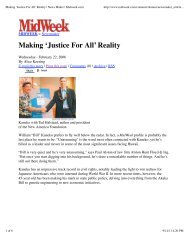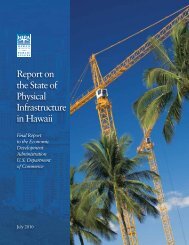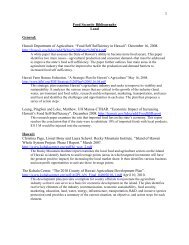Hawai'i Fisheries Initiative - The Hawaii Institute for Public Affairs
Hawai'i Fisheries Initiative - The Hawaii Institute for Public Affairs
Hawai'i Fisheries Initiative - The Hawaii Institute for Public Affairs
You also want an ePaper? Increase the reach of your titles
YUMPU automatically turns print PDFs into web optimized ePapers that Google loves.
2006 State Fishing<br />
Licenses and Permits<br />
n Commercial marine license: 3,137<br />
n Commercial bait license: 18<br />
n Commercial aquarium permit: 172<br />
n Recreational aquarium permit: 137<br />
n Special marine product possession and<br />
sale license: 92<br />
n Aquaculture facility license: 16<br />
n Aquaculture dealer license: 26<br />
n Locally caught Kona crab and<br />
lobster license: 64 219<br />
Annual Catch Limits and<br />
Accountability Measures<br />
Required under the 2006 MSA, Annual<br />
Catch Limits (ACLs) and Accountability<br />
Measures (AMs) seek to end and prevent<br />
overfishing in all U.S. commercial and<br />
recreational fisheries in 2010 <strong>for</strong> stocks<br />
subject to overfishing and in 2011 <strong>for</strong> all<br />
others. 220 To accomplish the goals <strong>for</strong> ACLs<br />
(also referred to as Total Allowable Catch,<br />
or TAC), “overfishing levels” first need<br />
to be established – an annual amount of<br />
catch that would result in overfishing if<br />
exceeded. <strong>The</strong> ACL would be set below<br />
this “maximum sustainable yield” (MSY)<br />
to ensure that overfishing does not occur.<br />
Such recommendations may not be in<br />
excess of the fishing level recommended<br />
by each fisheries council’s scientific and<br />
statistical committee or the peer review<br />
process established under the MSA. 221<br />
Wespac utilizes a precautionary approach,<br />
typically as follows: If its science and<br />
statistical committee reports a MSY of X,<br />
the council will set the cap or limit at 80<br />
percent of X. 222<br />
ACLs may be subdivided into sectors; <strong>for</strong><br />
example, an ACL could be set <strong>for</strong> types of<br />
fishing gear used, or whether the ef<strong>for</strong>t is<br />
commercial or recreational. AMs – action<br />
plans such as in-season closure once<br />
ACL is met or corrective measures taken<br />
during the next fishing year when an ACL<br />
is exceeded – may also be established<br />
<strong>for</strong> each sector. As Wespac designs and<br />
implements its ACLs and AMs, key considerations<br />
include the scientific knowledge<br />
of stocks, as well as monitoring and catch<br />
data reliability. 223 A precautionary approach<br />
could be taken when there is less scientific<br />
certainty about the health of a fish species<br />
or stock complex – a broader buffer zone<br />
between the (presumed) overfishing level<br />
and the ACL. ACL management measures<br />
do not require at-sea en<strong>for</strong>cement until<br />
after the annual catch limit is reached. 224<br />
NOAA’s Observer Program<br />
NMFS, via its Office of Science and<br />
Technology, deploys observers onboard<br />
commercial vessels to record catch and<br />
bycatch (catch of non-target species;<br />
52







